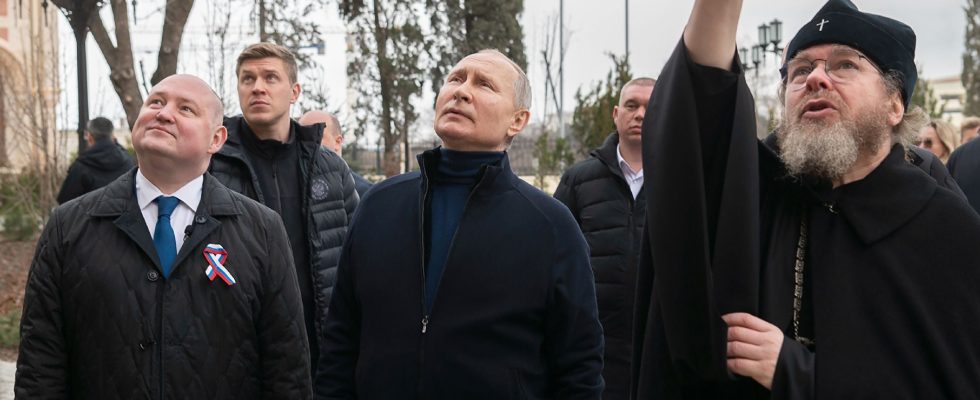Sunset over the creeks, vineyards on the mountainside, luxury hotel at 500 euros per night… In a video on YouTube, Bogdan Boulychev tells how he reached his “dream”, Crimea, after a road trip three days a little special. The Russian blogger first crosses Mariupol, razed by the Russians in 2022, but which he finds “full of life”. Then, with his three children, he raves about the state of the roads and the speed with which the family crosses the checkpoints guarded by soldiers flanked by a Z, before reaching their postcard destination.
Annexed by Moscow ten years ago during a referendum supervised by 20,000 Russian soldiers without insignia, the mountainous peninsula, as large as Brittany, is intended to be a showcase of modernity, a trophy for Vladimir Putin. But what Kremlin propaganda relays like Bogdan do not say is that the seaside region has become vulnerable to Ukrainian responses since 2022. Passing through Mariupol, Bogdan carefully avoids the 18-kilometer bridge over the Kerch Strait, inaugurated in 2018 by the Russian president. Symbol of the annexation, the 4 billion euro structure connecting Crimea to the Russian continent was hit in October 2022 and then in the summer of 2023 by Ukrainian fire. kyiv’s forces also succeeded in weakening the Russians by launching 184 attacks last year against the peninsula. The strikes, via drones or missiles, notably destroyed several ships and a submarine, which were anchored in strategic ports in the Black Sea.
Medical centers requisitioned for the army
As a result, “after February 24, 2022, tourism in Crimea, which the Russians had focused on, collapsed: the Simferopol airport does not work, the Kerch bridge is unreliable and the sanatoriums are used to treat injured Russian soldiers,” reports Ievgeniy Iaroshenko, of the Crimean association Krym SOS, based in kyiv. From a tourist destination, Crimea was transformed into a rear base for the invasion. According to the NGO, seven medical centers have been requisitioned. And both the Kerch Bridge and the new Kerch-Sevastopol highway are used to transport military equipment to the Kherson Front. “All the infrastructure projects carried out by the Russians over the last ten years serve their war machine,” protests Tamila Tasheva, permanent representative of the Ukrainian presidency to the Autonomous Republic of Crimea, in exile in Kiev.
To support this strategy, Moscow is pursuing a policy of massive replacement of the population. “One in three residents did not live there before 2014,” specifies Ievgeniy Iaroshenko, who recalls that the forced transfer of the population constitutes a war crime. Moscow would have settled between 500,000 and 800,000 of its citizens – including many military personnel and their families. In 2014, the peninsula had 2.3 million inhabitants. Nearly 100,000 fled persecution between 2014 and 2022 and around 100,000 others left after February 24, 2022, in particular to avoid being mobilized into the Russian army.
“There are more and more unknown faces and soldiers everywhere,” describes, from Kiev, Amina, a thirty-year-old from the Crimean Tatar minority, who took refuge in Kiev in 2014. “I am the fourth generation forced into exile by the Russians,” she sighs. In 1944, Stalin deported up to 400,000 Tatars to Central Asia, including Amina’s great-grandparents and grandmother. His parents returned to their village after the fall of the USSR. Unlike Amina, they remained after the annexation on “their historic lands” despite the severe repression against the 300,000 Crimean Tatars. “In 2015, they were forced to take Russian passports so as not to lose the right to property,” regrets Amina. Nearly 700 people have been prosecuted for “discrediting the Russian army” since the start of the invasion, sometimes for a simple post on Facebook. Searches and arrests in the Tatar community are regular, so much so that some opponents sleep clothed, fearing being woken up at dawn by the Russian FSB, as recounted in Newsweek journalist and activist Loutfiye Zoudiyeva. Before being arrested herself.
.
